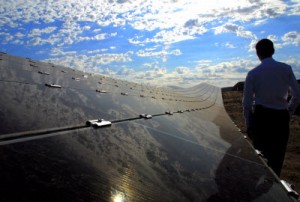Intel easily claims top spot on national green power list

This week isn't all bad on the news front for Intel. The high-tech giant landed solidly atop the U.S. Environmental Protection Agency's latest annual list of the top organization using what it defines as green power. Green power, in the EPA's mind, is anything that is generated from renewable sources including solar, wind, geothermal, biomass, and low-impact hydropower. It counts actual purchase as well renewable energy credits (REC), which means Intel is poised for continued leadership in the year to come. But more on that in a minute.
In terms of the latest list, Intel is No. 1 with an annual green power usage rate of 2.5 billion kilowatt hours, according to the EPA list. That's approximately 88 percent of its actual usage, and Intel's green focus is on biomass, geothermal proved to be Intel's biggest saving grace for this list. Even as the list was published, Intel announced a major planned increase in the number of renewable energy credits it will buy in 2011: up to 2.5 billion kilowatt hours. (Purchased through Sterling Planet.) That is approximately 75 percent over what it bought in 2010.

Says Brian Krzanich, senior vice president of Intel and general manager for manufacturing and supply chain:
"Intel's renewable energy efforts are meant to spur the market and make renewables cheaper and more accessible. Intel's REC purchases, support for solar installations and other clean energy investments will continue to be priorities for us as we search for effective sustainability opportunities around the globe."
I already mentioned that Kohl's is No. 2 on this list. Here's the complete 2 through 10, along with their annual commitment to green power (and the percentage of total power usage):
- Kohl's Department Stores = 1.4 billion kilowatt hours (100 percent)
- Whole Foods Market = 817.7 million kilowatt hours (100 percent)
- Starbucks = 573.4 million kilowatt hours (55 percent)
- Commonwealth of Pennsyvlania = 500 million kilowatt hours (50 percent)
- City of Houston, Texas = 438 million kilowatt hours (34 percent)
- Johnson & Johnson = 416.5 million kilowatt hours (39 percent)
- Staples = 341.5 million kilowatt hours (52 percent)
- City of Dallas, Texas = 302.9 million kilowatt hours (40 percent)
- HSBC North America = 300 million kilowatt hours (112 percent)
I also scoured the list for other high-tech/IT companies that made the top 50 list. Here's who shows up to the party:
- Cisco Systems = 270.2 million kilowatt hours (29 percent)
- Sony Corp. of America = 144 million kilowatt hours (49 percent) Note: That is almost double the previous year
- Motorola = 119 million kilowatt hours (32 percent)
- Dell = 114 million kilowatt hours (28 percent)
- Spring Nextel = 87.6 million (3 percent)